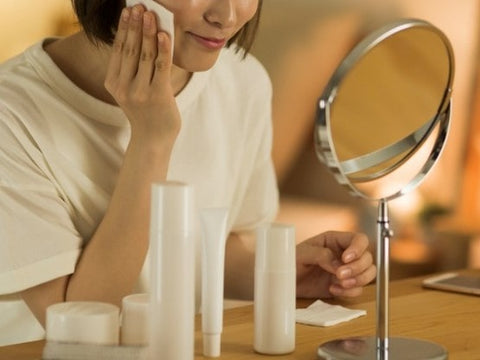Winter is the season when our skin really struggles, it’s getting colder outside and our central heating is drying the air inside. You may notice your skin becoming dry, a sensation of tighter skin, tingling or even a powder-like residue on your skin.
So what is our skin calling out for in Winter, and how can we try and counteract the damage and strain it’s causing? Read on for more info!

Why does the Winter cold cause these issues? Well, as the temperature drops, the humidity levels also drop and the air dries. As the air around us becomes drier, our skin can become deprived of moisture and this in turn makes it easier for the water/ oil balance to become unstable. This balance is essential for maintaining moisturised and healthy skin. And central heating? This exacerbates the dryness of the air, thus further drying out your skin.
Our skin is actually divided into several layers, such as the epidermis, dermis and subcutaneous tissue. The outermost layer is the epidermis, and the outermost layer of the epidermis is the stratum corneum. This is made up of 10 to 30 thin layers, continually shedding and being replaced with new layers of strong, long-wearing cells. This shedding process slows down with age, with complete cell turnover taking around 28-30 days in young adults, and 45-50 days in elderly adults.
So why is all this important when talking about skincare? Well, the barrier function of our skin (specifically the stratum corneum) is really important - it prevents the evaporation of moisture, prevents the skin from dryness and protects against external stimuli, stores moisture and keeps the skin hydrated, healthy and beautiful. Reduced barrier function, therefore, means that our skin can’t protect itself from external stimuli or properly store moisture, and this, in turn, can cause dry skin.
Another issue that can cause issues is the wrong skincare regime or using a product that doesn’t suit your skin. For example, rubbing the skin too roughly while cleansing can strain the skin and lead to decreased barrier function. If your skin feels taut or dry after using certain skincare products, take a closer look at them and make sure they’re not exacerbating the issue.
So what are our recommended skincare tips?
Step 1: Super-Speedy Post-Cleanse Moisturising
After washing or cleansing your face, try to immediately give it some moisture, reducing the opportunity for moisture to escape from your skin. Toner is a great way to do this and helps your moisturiser better absorb into the skin. You can use reusable cotton pads, but placing it in the palm of your hands and gently applying it over the face helps boost hydration with minimal skin strain.
We recommend products with ingredients with high moisturising power, such as oats. Our Steamcream Toner is blended with oat kernel extract, aloe, mineral-rich carrageenan and 9 essential oils.

Step 2: Gentle Cleansing
Over-cleansing and placing too much pressure on the skin can cause it to become irritated or strained, so we recommend a ‘Gentle, Slow and Careful’ approach. Apply a cleanser in a slow, circular motion, rinsing with lukewarm water. Try not to wash your face too much, as this is also a process when your skin can become deprived of moisture. After rinsing, gently pat your face dry, without rubbing the skin on your face.
Our Cleansing Balm is blended with highly moisturising Sugar Squalane, antioxidant Grapeseed oil, Almond oil and Oat Kernel Oil, creating a 3-phase balm that gently and effectively removes impurities and makeup, and after rinsing the skin feels smooth, fresh and plump.

Step 3: Review your Lifestyle
Your daily diet and general health also impact the health of your skin. Eating a balanced diet, packed with essential vitamins, minerals and proteins, is essential for healthy skin. Dietary fibre and lactic acid bacteria (think fermented foods like kefir, yoghurt, cheese etc.) can improve your intestinal health, which subsequently impacts skin health. And getting a good night’s sleep and moderate exercise activates turnover and increases the amount of water retained in the skin.
Step 4: Humidity Control
The optimal humidity for the skin is 50-60%, and anything below 40% can cause skin to feel dry. Think about buying a hygrometer, so you can check humidity levels in the house, and if your central heating is causing low humidity, use a humidifier to boost levels. If you don’t have a humidifier, you can also spray water into the air to increase humidity a little. Our Eucalyptus & Tea Tree facial mist can also help boost hydration levels.
Step 5: Hydrate the Body
It’s not just our skin that needs hydration, we also need to make sure we keep hydrated during the day. The body is said to circulate and lose around 2.5 litres of water a day. In the winter it can be easier to forget as it’s not as hot, and we’re not always as active as in the summer. Everyone is different, but try and drink around 1.5 litres a day to stay hydrated.
Another interesting fact? A cold body can cause poor blood circulation and this will reduce the barrier function of the skin, so it’s actually recommended to drink water that’s at room temperature or lukewarm.

Dry skin can not only feel extremely sensitive and uncomfortable, it can also cause issues with make-up caking or not sitting properly on the skin. We hope the above tips help boost your hydration levels and do let us know if you have any other tips or advice for Winter skin survival!
Adapted from an article by Ms. Yuka Ito, an editor and writer in Japan.



